|
|
|
|
Why measure and monitor the improvement
in plant performance when the Scale-X MFCs have been
installed.? |
|
When MFCs are installed it is preferable to determine the
benefits they produce. A statistical and/or graphical analysis
of the plant performance best demonstrates the benefits.
Efficiency is of utmost importance in air-conditioning systems,
particularly in large building systems in countries where the
system operates for 12 months of the year. For example, in
south-east Asia the cost of running the air-conditioning systems
in large shopping centres is 60% to 70% of the overall cost of
running the center. Reduced efficiency costs money..!!
Magnetic Technology Australia recommends that each client
install appropriate instrumentation to measure and monitor the
benefits and performance of the Scale-X MFCs. This
instrumentation has other benefits for the client as it can
alert the operator to problems on the plant not associated with
MFC performance.
|
|
Building Air-Conditioning Systems
Measuring performance of MFCs on a
building air-conditioning system. |
|
Efficiency in simple terms, is
a measure of the power consumed for each refrigerated ton (RT)
of cooling produced. For electrically operated chillers it is
the electricity required to run the compressor (plus the
electricity for the pumps and fans of the cooling water system)
to produce each RT. For gas operated chillers it is gas consumed
(plus the electricity for the pumps and fans of the cooling
water system) to produce each RT.
The following simplified diagram shows the instrumentation
required to measure and monitor the efficiency and performance
of the air-conditioning system.
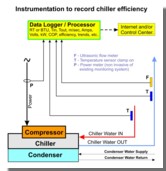
Instrumentation schematic for measuring and
monitoring air-conditioning systems efficiency.
The following diagram shows the typical efficiency curves for
operation of a condenser/chiller and cooling tower
air-conditioning system. For a system operating with MFCs only,
the is maintained at 100%. Whereas a system using chemical
dosing, the efficiency initially drops away quickly due to the
fast formation of biofilm (slime) and then continues to reduce
due to the combined effect of scale formation and biofilm.
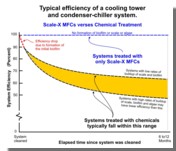
Air-conditioning
system
efficiency trend curves
for Scale-X MFCs - verses - chemical dosing.
|
|
Offshore Platform
Production Systems
Measuring the performance of
the MFCs on the Tinggi A offshore platform production
system. |
|
The main scaling points which affected platform production was at the second
separation vessel stand pipe outlets and down stream valves.
As the system scaled the pressure in the separation vessel was increased and the
liquid level raised. This was in an endeavour to force the liquids through
the restrictions to flow caused by the scale build-up and to maintain production
output levels. These were the parameters monitored and measured by the
operators as shown graphically below.
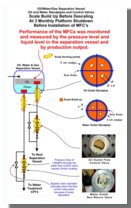
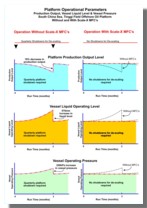
|
|
|
|
Dairy Evaporator
Systems
The importance evaluating the benefits
and improved plant performance resulting from the
installation of Scale-X MFCs on a dairy evaporator /
concentrator. |
|
As an evaporator scales up the steam supply has to be ramped up
to compensate for the insulating effect (low thermal
conductivity) of the scale. The installation of MFCs reduces the
rate of scale deposition. This in turn reduces the rate at which
the steam supply to the evaporator needs to be ramped up. It
also reduces the rate at which the temperature in the
controlling effect or finisher ramps up.
This information provides a basis on which the plant operators
can determine the operational
objectives which provides the greatest returns for investment
for the company. For example, which method of operation is
best:-
● Maximize run time with minor reduction in CIP time -
or to
● Extend run time while achieving a reduced CIP time -
or to
● Minimize CIP time with little or no increase in run
time.
|
|
Method of measuring the improved
performance of the evaporator with Scale-X MFCs. |
|
By plotting the percent steam valve opening and/or
temperature in the evaporator against length of run time, the
benefits of installing the MFCs can be statistically or
graphically shown. This should be done for 30 or more runs
before the MFCs are installed and again 30 or more runs after
installation of the MFCs.
The following two graphical representations show the comparison
of operating without MFCs and with MFCs of how the heat transfer
efficiency progressively declines and the temperature in
the controlling "effect" or "finisher" rises as the system
scales. The function which is the controlling determinant
of when it is no longer practical to continue operating the
evaporator is the temperature in the controlling "effect" or
"finisher".
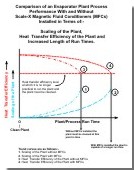
Heat transfer
efficiency - verses - length of run.
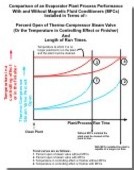
Percent open of thermo-compressor steam valve
- verses - length of run
The product output concentration level is set for each
production run and determines the percent opening the steam
valve. The following diagrams are:-
● a simplified sketch of the product concentration level feed
back signal to the steam valve and
● an example of the feed back signal on a lactose
evaporator.
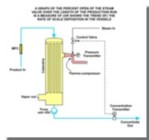
Product
concentration
level
feed back to steam valve
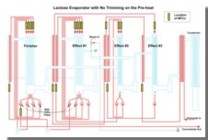
Feed back
signal on a lactose evaporator

|
|